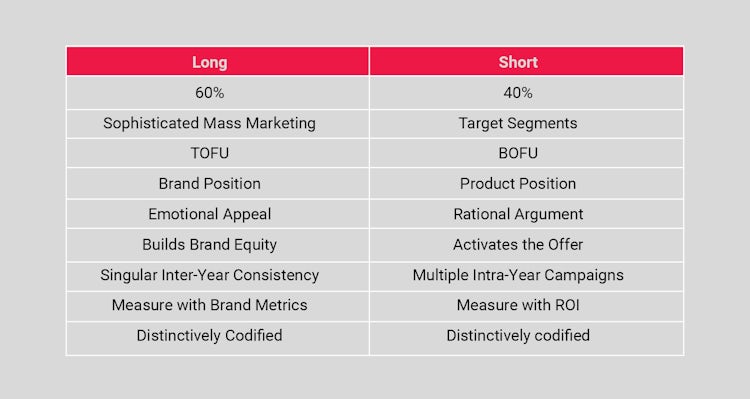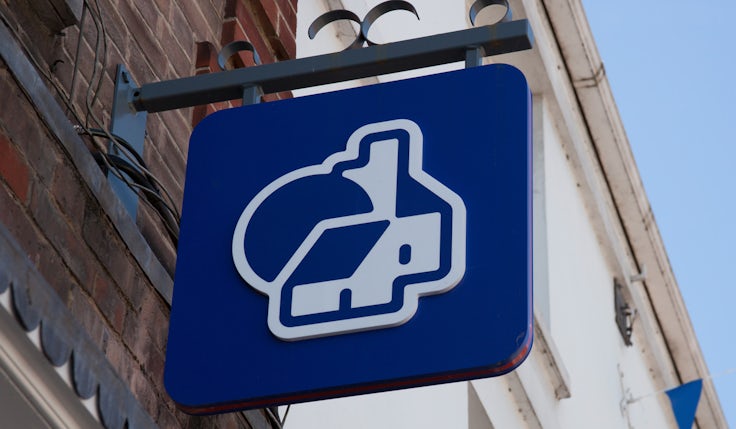Can you achieve long and short at the same time? Usually, no
It’s appealing to fulfil brand and sales objectives in one execution, but they’re so different that you’ll probably fail at both.

About five years ago we bought a cottage in the nearest city to our very remote house. It was a tiny thing. But it enabled us to go out for dinner and drink wine and walk home – none of which had been possible in the country. Well, the drinking wine bit was very fucking possible, too fucking possible in the country. But the other two just weren’t doable until we bought our tiny cottage.
Inside we found two bedrooms, a little living room and a floating kitchen island. It had been painted a neutral off-white colour, but it was begging for a decent lick of something more interesting. My wife and I looked at each other, our minds honed from the perfection of our idyllic 20-year marriage, and said in unison: “Green.” “Pink.”
Mrs R wanted a strange spearmint Ikea green (my words, not hers). I wanted a more optimistic “metrosexual midlife-crisis pink” as she titled it.
And I am ashamed to say we then argued about it for months. Years. Pans were flung. Doors banged. Upbringings questioned. Samples bought and tested. But when we each painted a little patch of island territory our own special colour it only made each of us more certain that we were right, and the other wrong. We reached stalemate and left our little painted sections as reminders of our divided state. Our little island became Cyprus.
Until last week. As I headed into the kitchen to make an early brew, my eye was caught by something. Between the green and pink splotches that had become our standard debated décor, something new had appeared. At first, I thought one of the dogs had eaten something and had a projectile episode. Or that the mice had staged their very own dirty protest. About a foot from the floorboards, our island now had what I can only describe as a shit stain.
It turns out that Daughter No.1 had grown weary of the Pantone War. Showing wisdom, if not taste, beyond her years she had mixed the two opposing sample tins into a single colour and slapped it all over the island. And when you blend a predictable, dated shade of green with a magnificent, daring pink you get… well, shit brown.
There are no absolutes in marketing, despite what the marketing scientists, running towards you across the field in their white coats, might want you to believe.
Hold that unfortunate pantone in your heads for a few paragraphs. We will need it later.
There is almost no debate about the veracity of The Long and the Short of It. Les Binet and Peter Field’s master work is the perfect exemplar of marketing ‘bothism‘. Sure, there are a few marketing pedants grumbling about skewed samples and inappropriate analysis but, outside of the circle jerk of ‘marketing Twitter’, every CMO and brand manager I know understands the theory and attempts to apply it as best they can.
That’s partly attributable to the quality of the work done to explain The Long and the Short of It. And partly because of the disciplinary respect everyone has for Field and Binet – the Siegfried and Roy of effectiveness.
But that consensus only exists at the strategic level. Sure, every good marketer wants to ensure they build brand and activate sales accordingly and in harmony. But, at the tactical level, how that double whammy is achieved is currently a matter of some debate. You can clearly observe two very different schools of thought when it comes to how long-term brand building and shorter-term performance are achieved. We might title them the ‘Double-Duty Squad’ and the ‘Two-Speed Zealots’.
Watch: Ritson’s nine marketing effectiveness lessons
Two-Speed Zealots
The Zealots follow the traditional dogma of Field and Binet. They argue that you should build brand and activate sales but that these conjoined missions are best attempted using a different budget and different tactical mix. Seen this way, the 60/40 split is not just budget guidance but a reminder to add that backslash to all campaign work and divide it in two.
Long-form, long-running and more traditional media – mass-targeted and more emotional – works to build the brand with little or no call to product action. Shorter, multiple campaigns target specific segments for immediate activation, often taking a more digital turn. The work is linked by distinctive brand assets, so that the codes and brand associations that are conjured up in the brand work are then immediately activated and utilised in all the short promotions.
Long feeds short. Short pays for more long. Money is made.
The Double-Duty Squad
The Squad get the long and short of it but, as one senior marketer put it to me recently, “don’t see why brand and selling cannot happen within the same execution”. Rather than separate their campaign into two distinct units, the goal is to create advertising that builds brand and then sells product.
There seem to be three main arguments for the double-duty approach. First, we used to do it back in the day, sonny, so why have we suddenly decided we need separate campaigns? Second, it’s too expensive to split a budget in half to do two jobs, when you barely have enough spend for one campaign. Finally, when you look at the piss-poor rates of proven recall for advertising, its simply not practical to build brand with one ad and then hope the connection endures long enough to be activated by an even less well remembered performance campaign. Better to make marketing hay while the sunshine of attention shines upon your single ad.
And, of course, both schools are making strong arguments. Neither is wrong. I see the attraction and advantages of double duty. But personally, I am a Zealot. I challenge clients to separate budgets and to approach long and short very differently. And I do that for a couple of very important reasons.
First, I think most of the Double-Duty Squad underestimate the paradigmatic differences between the long and the short. It’s not just the time scale for the marketing activity that separates one from the other. They are contradictory on so many levels as to be almost alien to each other. It’s becoming more and more apparent, for example, that, if you have the budget, it does make more sense to build the brand to the total ‘sophisticated’ mass market, to use Byron Sharp’s phrase.
But it’s equally apparent that you want your head examined to try to activate sales on that mass level, when actionable target segments yield so much better results. In B2B marketing, for example, you clearly want to build brand to the whole market. But you want your sales teams, who represent the short of it, to target specific accounts with specific messages at specific times.

When you position for the long of it, you just need your brand values and distinctive assets and then amazing creative work that brings this to life. For the short of it, you need old-style positioning statements with clear product benefits, aimed at specific segment needs and versus particular category alternatives. Similarly, while the best brand campaigns tend to be a variation on a single long-running theme stretched over many years, the challenge of activation requires multiple overlapping campaigns aimed at different periods, segments and opportunities across a marketing year.
And of course, there is the thorny issue of effectiveness. While the brand-building stuff is almost impossible to account for in financial terms – whatever your research agency tells you – the short stuff can and should be assessed with simple ROI metrics that compare what it cost versus what revenue it brought in.
‘It’s about long-term value’: How brands are tackling effectiveness measurement
Put simply, The Long and the Short of It isn’t just the long and the short of it. It’s the brand and the product. The TOFU and the BOFU. The sophisticated mass market and the many target segments. The brand position and the product positions. The story of singular inter-year consistency and multiple intra-year campaigns. It’s the brand metrics and the ROI. It’s the fancy agency with a nice sofa in their reception in Soho, and the two quant jocks who forgot to shower, again.
It’s so totally different on so many important levels that trying to get a single ad of any variety to do both is, not impossible, but highly unlikely to be as effective as splitting up your budget and acknowledging the two connected games that need to be played. And then playing them differently.
And there is evidence of this from Siegfried and Roy themselves. They have long counselled against the idea of double duty. And, when they compared campaigns that aimed to build brand and sell product in a single execution versus those that follow the two-speed approach, they found significant advantages in the latter camp.
 Of course, you can be successful with double duty. Field and Binet’s own data shows that very clearly. There are no absolutes in marketing, despite what the marketing scientists, running towards you across the field in their white coats, might want you to believe. But the odds are stacked against you.
Of course, you can be successful with double duty. Field and Binet’s own data shows that very clearly. There are no absolutes in marketing, despite what the marketing scientists, running towards you across the field in their white coats, might want you to believe. But the odds are stacked against you.
When my six-year-old mixed green and pink together it was possible that she would create a lovely colour that everyone would adore. We’d then spend a harmonius weekend painting it all over the kitchen island while occasionally embracing each other and high fiving in slow motion.
But that didn’t happen. Instead we have a shit-brown stain all over our island and a potent reminder that sometimes – most times – synergy and efficiency are just fancy words for compromise. And the best approach is to paint one side of the island pink and the other, pink. I mean green.







